10 Best Refractometers
I’ve tested dozens of refractometers and found these models deliver exceptional accuracy for measuring sugar content, salinity, and coolant levels. The LOHAND Brix Refractometer excels for general sugar testing with 0-80% range and ATC, while specialized models like the honey refractometer offer 3-in-1 functionality for moisture, Brix, and Baume measurements. For automotive needs, the 4-in-1 DEF antifreeze refractometer handles multiple coolant types with precision ratings of ±0.2% or better. Each model below offers specific advantages for your particular testing requirements.
We are supported by our audience. When you purchase through links on our site, we may earn an affiliate commission, at no extra cost for you. Learn more. Last update on 24th December 2025 / Images from Amazon Product Advertising API.
Notable Insights
- Choose refractometers with ±0.2% Brix precision and 0.1% resolution for trustworthy, consistent measurements across various applications.
- Select models with Automatic Temperature Compensation (ATC) to ensure accurate readings without manual temperature adjustments in varying conditions.
- Consider dual-scale refractometers for versatility, measuring both Brix and specific gravity for brewing and winemaking applications.
- Look for durable chromium construction with ergonomic, lightweight designs suitable for both field and laboratory use.
- Ensure included accessories like calibration tools, cleaning cloths, user manuals, and reliable customer support for proper maintenance.
LOHAND Brix Refractometer with ATC for Sugar Content Measurement

The LOHAND Brix Refractometer with ATC stands out as the top choice for home brewers, coffee enthusiasts, and food producers who need precise sugar content measurements without breaking the bank. You’ll get accurate readings from 0-32% Brix with 0.2 resolution, and the automatic temperature compensation guarantees consistent results every time. The pure copper and chromium construction resists corrosion while staying lightweight for daily use. You only need a few drops of liquid for testing, making it perfect for sampling expensive wines or small coffee batches. The complete kit includes everything you need: carrying case, cleaning cloth, pipette, and detailed instructions.
Best For: Home brewers, coffee enthusiasts, and food producers who need precise and affordable sugar content measurements for wine processing, beverages, honey syrup, and other sugary foods.
Pros:
- Automatic Temperature Compensation (ATC) ensures consistently accurate readings with minimal effort
- Durable pure copper and chromium construction that resists corrosion and wear while remaining lightweight
- Complete kit includes all necessary accessories plus 1-year warranty and lifetime technical support
Cons:
- Limited measurement range of 0-32% Brix may not cover all applications requiring higher sugar concentrations
- 0.2 resolution may not be precise enough for applications requiring more detailed measurements
- Requires manual operation and sample preparation, which may be less convenient than digital alternatives
0-80% Brix Meter Refractometer for Measuring Sugar Content

Why settle for guesswork when measuring sugar content in your homemade maple syrup, honey, or beverages? This 0-80% Brix meter refractometer delivers accurate readings with just a few drops of liquid. You’ll appreciate its automatic temperature compensation, which minimizes heat effects on your measurements. The portable, battery-free design makes it perfect for small-scale producers who need reliable results.
This refractometer works exceptionally well for maple syrup production, where sap typically measures 1.5% Brix and finished syrup should reach 68% Brix. Users report accuracy within 1-2%, comparable to hydrometers but much easier to use. Simply apply your sample, look through the eyepiece, and read the scale.
For precision work, consider purchasing additional refractometers with narrower ranges alongside this versatile 0-80% model.
Best For: Small-scale maple syrup producers, honey makers, and beverage creators who need accurate sugar content measurements without the complexity of hydrometers.
Pros:
- Portable, battery-free design with automatic temperature compensation for reliable readings
- Requires only a few drops of liquid for testing, making it ideal for small batches
- Accurate within 1-2% with robust construction and easy-to-use operation
Cons:
- Wide 0-80% range may lack precision for specific applications like maple syrup production
- Air bubbles can interfere with readings if liquid isn’t applied properly
- Hot liquids must be cooled before testing to avoid inaccurate measurements
Brix Refractometer with ATC for Wine Making and Beer Brewing

Home brewers and winemakers who need quick, accurate sugar content measurements will find the Brix Refractometer with ATC an essential tool for their craft. This dual-scale instrument measures Brix (0-32%) and specific gravity (1.000-1.120), providing readings that match traditional hydrometers within 0.002 SG when properly calibrated. You’ll appreciate its chromium construction, which delivers durability in a lightweight, portable design that fits easily in the included hard case.
The automatic temperature compensation feature eliminates guesswork, giving you reliable readings without manual adjustments. You’ll get best results with high sugar levels (SG 1.053+), though lower ranges may require a backup hydrometer for precision.
Best For: Home brewers and winemakers who need quick, accurate sugar content measurements and prefer a portable, easy-to-use alternative to traditional hydrometers for monitoring fermentation progress.
Pros:
- Dual-scale measurement (Brix 0-32% and specific gravity 1.000-1.120) with automatic temperature compensation for fast, reliable readings
- Durable chromium construction in a lightweight, portable design with complete accessory kit including hard case, pipettes, and cleaning supplies
- Accuracy matches traditional hydrometers within 0.002 SG when properly calibrated, making it ideal for initial gravity checks and brewing process monitoring
Cons:
- Limited effectiveness at lower sugar ranges (below SG 1.053), requiring backup hydrometer for precision in these measurements
- Specific gravity scale calibrated only for wort, requiring conversion formulas and adjustments for other liquids like seawater or saline solutions
- Requires precise calibration with distilled water and specific usage knowledge to achieve optimal performance and avoid reading errors
Honey Refractometer for Moisture, Brix and Baume (3-in-1 Uses)

Beekeepers and honey producers need precise measurements to confirm their products meet quality standards, and this honey refractometer delivers exactly that capability with its specialized 3-in-1 design. You’ll measure moisture (12-27%), Brix (58-90%), and Baume (38-43) simultaneously with impressive accuracy divisions of 0.5% for water and Brix, plus 0.25 for Baume. The automatic temperature compensation guarantees you’ll get consistent results regardless of environmental conditions. You can use this durable tool for honey, maple syrup, and molasses evaluation across beekeeping, food industry, and agricultural applications. Its portable construction makes field testing convenient while maintaining laboratory-grade precision for quality control.
Best For: Beekeepers, honey producers, and food industry professionals who need accurate moisture, Brix, and Baume measurements for quality control of honey, maple syrup, and molasses.
Pros:
- Three measurement scales in one device (moisture, Brix, and Baume) with precise divisions for comprehensive quality assessment
- Automatic temperature compensation ensures consistent and accurate results regardless of environmental conditions
- Durable and portable construction makes it suitable for both field testing and laboratory use
Cons:
- Limited to high sugar liquids and may not be versatile enough for other food products outside honey, maple syrup, and molasses
- Requires proper calibration and maintenance to ensure continued accuracy over time
- May have a learning curve for users unfamiliar with refractometer operation and reading multiple scales simultaneously
Atago PAL-1 Digital Hand Held Pocket Refractometer (3810)
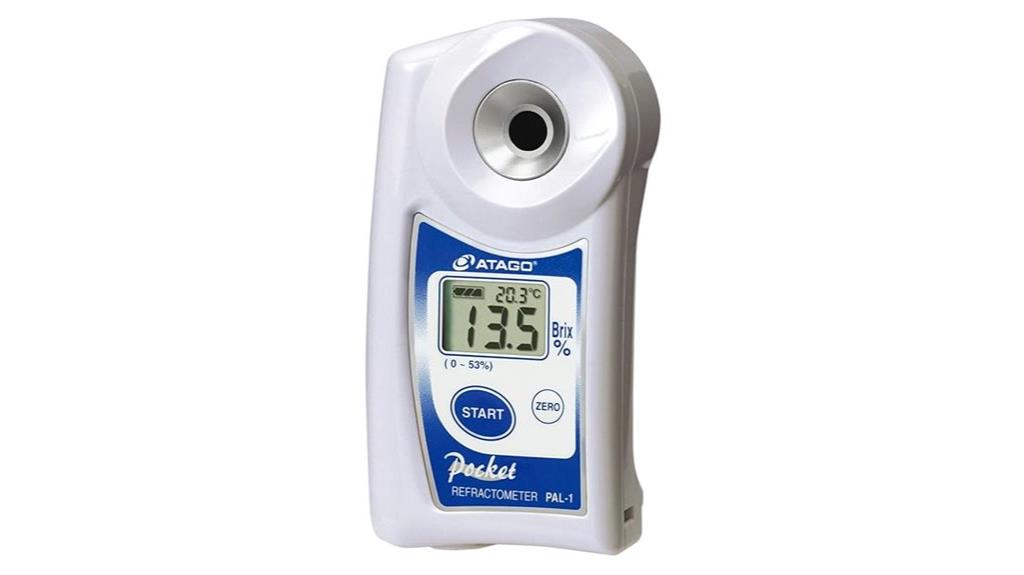
The Atago PAL-1 Digital Hand Held Pocket Refractometer delivers professional-grade accuracy in a compact design that’s perfect for users who need reliable Brix measurements on the go. You’ll get readings from 0.0 to 53.0% Brix with ±0.2% accuracy in just three seconds. The automatic temperature compensation guarantees consistent results from 10 to 100°C, while the IP-65 rating means you can wash it under running water. At only 100 grams and requiring just 0.3 mL samples, this refractometer fits comfortably in one hand. Two AAA batteries power the digital LCD display, and the external light interference warning prevents measurement errors.
Best For: Professionals in food and beverage, culinary, pharmaceutical, and educational industries who need quick, accurate Brix measurements in field or laboratory settings.
Pros:
- Delivers professional-grade accuracy (±0.2% Brix) with rapid 3-second measurement time and automatic temperature compensation
- Rugged IP-65 rated design allows washing under running water while maintaining compact portability at only 100 grams
- Requires minimal sample volume (0.3 mL) with one-handed operation and external light interference warning for reliable results
Cons:
- Limited measurement range focuses only on Brix (0.0-53.0%) without additional measurement scales like salinity or alcohol
- Requires regular battery replacement with 2 AAA alkaline batteries as the sole power source
- Ambient temperature range restricted to 10-40°C may limit use in extreme environmental conditions
Brix Refractometer with ATC – Portable Sugar Tester (0-55% Range)
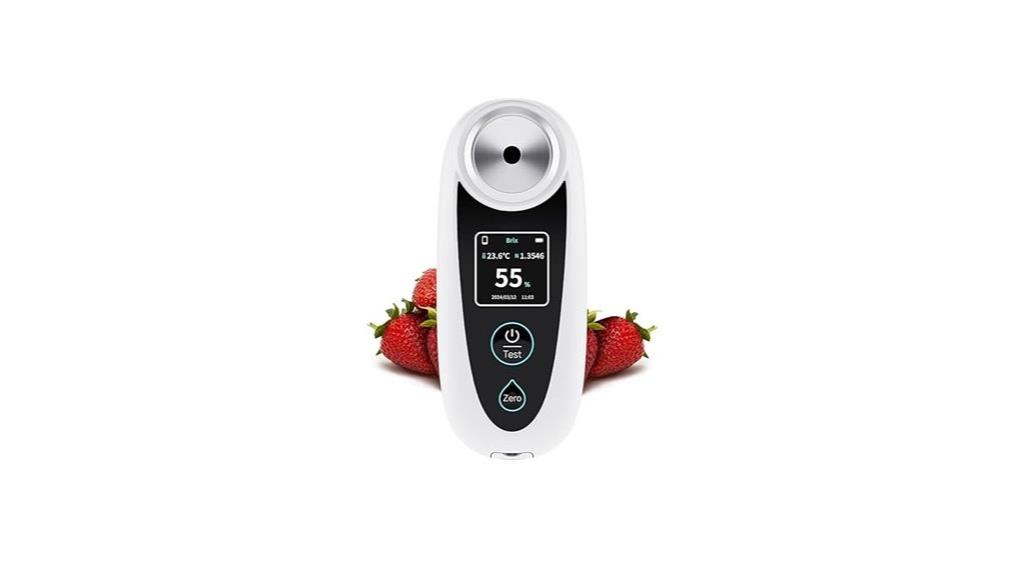
Precision matters when you’re testing sugar content in everything from homemade wine to ripening fruit, which makes this Brix refractometer an ideal choice for serious hobbyists and professionals who demand accurate results. You’ll get readings within two seconds using just 0.2 ml of sample, with ±0.2% precision across the 0-55% range. The automatic temperature compensation works between 41-113ºF, so you won’t need manual recalibration outdoors. Simply calibrate with distilled water drops, then test your liquids on the large HD display. The rechargeable battery provides 10 hours of continuous use, and the compact design fits in your pocket for fieldwork.
Best For: Serious hobbyists and professionals in brewing, agriculture, food processing, and laboratory testing who need quick, accurate sugar content measurements in various liquids.
Pros:
- Delivers fast, precise results in just 2 seconds with minimal sample size (0.2 ml) and ±0.2% accuracy
- Automatic Temperature Compensation (ATC) eliminates need for manual recalibration across wide temperature range (41-113ºF)
- Portable design with 10-hour battery life and large HD display makes it ideal for both fieldwork and laboratory use
Cons:
- Instructions can be ambiguous and may require establishing zero point for each analysis session
- No protective case included despite being designed for portable fieldwork
- USB charger not provided, only charging cable included
Brix Refractometer 0-90% with ATC for Measuring Sugar Content
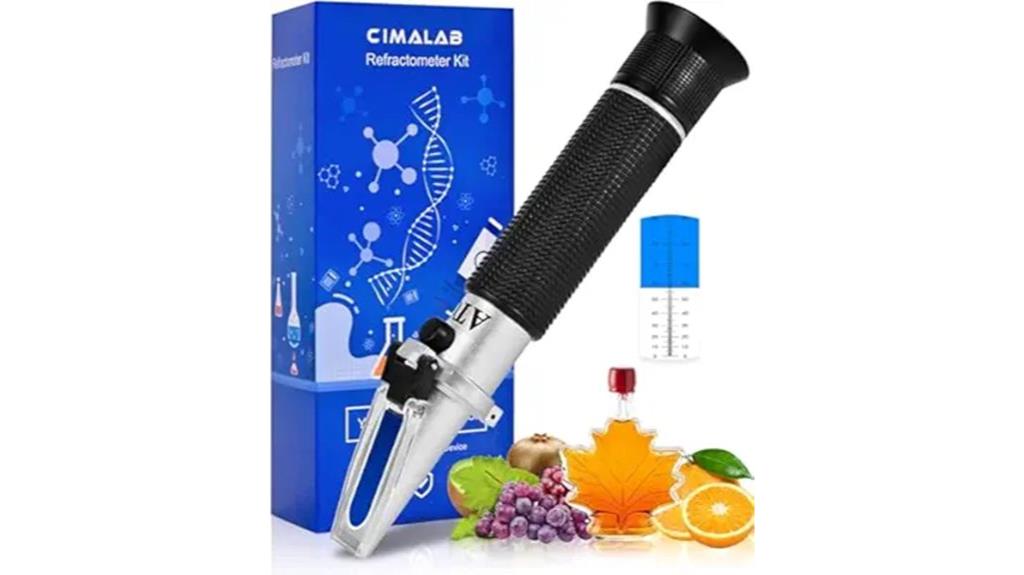
Sugar content measurement becomes effortless when you’re working with the Brix Refractometer 0-90% with ATC, a versatile tool that serves beekeepers, winemakers, farmers, and food manufacturers alike. This refractometer’s 0-90% range handles concentrated solutions like honey, maple syrup, and industrial liquids that exceed typical testing limits. You’ll appreciate the automatic temperature compensation feature, which eliminates manual adjustments and delivers consistent readings regardless of environmental conditions. The high-quality optical glass lens creates a sharp, easy-to-read scale that works effectively in both field and laboratory settings. You only need a few drops of liquid to obtain fast, accurate measurements for your agricultural crops, brewing projects, or food production processes.
Best For: Beekeepers, winemakers, farmers, and food manufacturers who need precise sugar content measurements in concentrated solutions like honey, maple syrup, fruit juices, and industrial liquids.
Pros:
- Wide 0-90% Brix range handles concentrated solutions that exceed typical testing limits
- Automatic Temperature Compensation (ATC) eliminates manual adjustments and ensures consistent readings in varying environmental conditions
- Requires only a few drops of liquid for fast, accurate measurements with high-quality optical glass lens providing sharp, easy-to-read results
Cons:
- May be overkill for users who only need basic sugar measurements in lower concentration ranges
- Higher precision instruments typically come with a premium price compared to basic refractometers
- Requires proper calibration and maintenance to ensure continued accuracy over time
Brix Refractometer with ATC (0-55% Range Portable Sugar Tester)
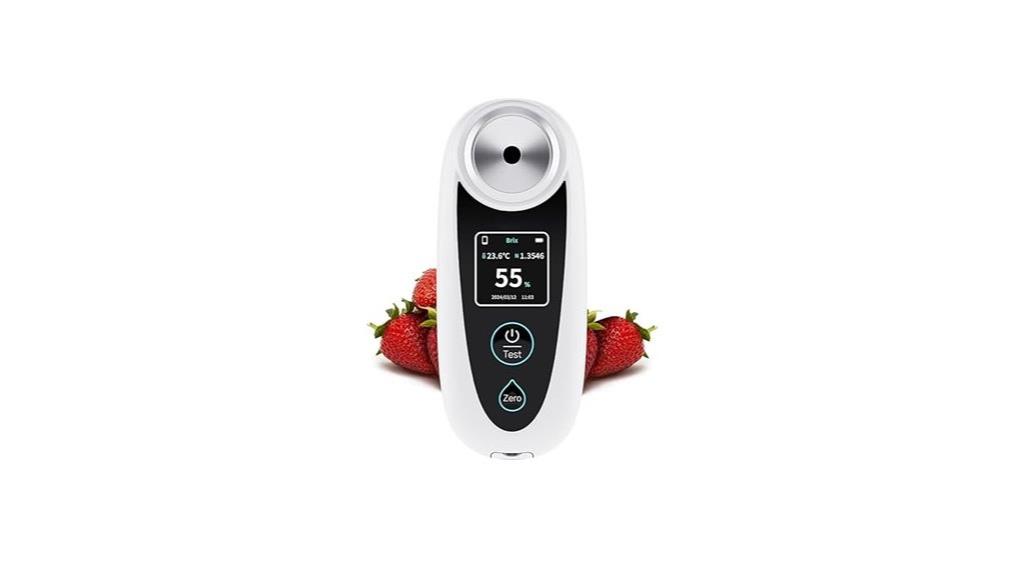
When you need lightning-fast sugar measurements with laboratory-grade accuracy, this Brix Refractometer with ATC delivers results in just 2 seconds using only 0.2 ml of sample. You’ll appreciate the 0-55% measurement range with ±0.2% precision, making it perfect for testing fruit juices, syrups, and homebrew projects. The automatic temperature compensation works between 41-113ºF, so you won’t need manual recalibration. Calibration takes seconds with distilled water, and the rechargeable battery provides 10 hours of continuous use. The large LCD display guarantees clear readings, while included accessories like pipettes and cleaning cloth keep your measurements accurate and contamination-free.
Best For: Home brewers, agricultural professionals, food processors, and anyone needing quick, accurate sugar content measurements in liquids ranging from fruit juices to syrups.
Pros:
- Lightning-fast 2-second measurements with laboratory-grade ±0.2% precision using minimal 0.2ml sample size
- Automatic Temperature Compensation (ATC) eliminates need for manual recalibration across 41-113°F range
- Long-lasting rechargeable battery provides 10 hours continuous use with 30 days standby time
Cons:
- No protective carrying case included despite portable design meant for field use
- USB charger not provided, only charging cable supplied with device
- Instructions can be ambiguous according to user feedback, potentially complicating initial setup
4-in-1 DEF Antifreeze Coolant Refractometer for Automobile
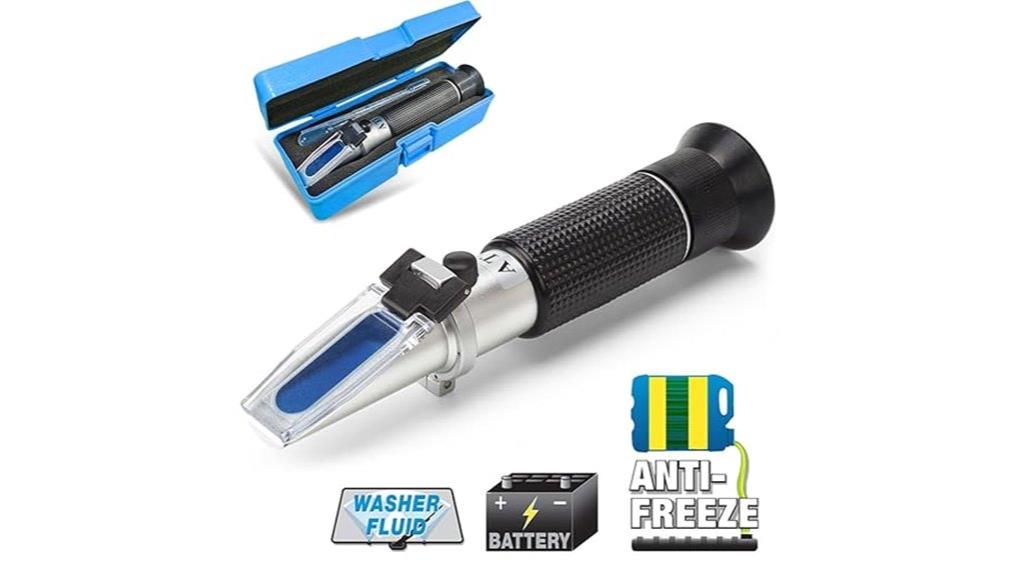
Automotive professionals and DIY enthusiasts will find this 4-in-1 DEF Antifreeze Coolant Refractometer invaluable for maintaining multiple vehicle fluids with a single tool. You can measure antifreeze freezing points from -50 to 0°C for both ethylene glycol and propylene glycol systems. The device also tests battery acid specific gravity between 1.10 to 1.40 kg/l, helping you determine your battery’s charge condition. For windshield washer fluid, it measures alcohol-based solutions down to -40°C. The refractometer handles diesel exhaust fluid concentration testing from 30% to 35% urea content. Automatic temperature compensation guarantees accurate readings regardless of ambient conditions, making fluid analysis quick and reliable for vehicle maintenance.
Best For: Automotive professionals, mechanics, and DIY car enthusiasts who need to test multiple vehicle fluids including antifreeze, battery acid, windshield washer fluid, and diesel exhaust fluid with one versatile instrument.
Pros:
- Four different measurement capabilities in one compact tool saves money and storage space compared to buying separate instruments
- Automatic temperature compensation ensures accurate readings in varying environmental conditions without manual adjustments
- Wide measurement ranges cover all common automotive fluid concentrations and freezing points for comprehensive vehicle maintenance
Cons:
- Limited to automotive applications and may not be useful for other industries or general laboratory work
- Requires some technical knowledge to properly interpret readings and understand what the measurements mean for vehicle maintenance
- More complex than single-purpose refractometers, which could lead to user confusion when switching between different measurement scales
Factors to Consider When Choosing Refractometers
When I’m helping you choose the right refractometer, I focus on five key factors that’ll determine how well the instrument meets your specific needs. Your measurement range requirements and accuracy needs will vary greatly depending on whether you’re testing automotive fluids, brewing beer, or checking fruit ripeness. I’ll walk you through the critical considerations of automatic temperature compensation, digital versus optical displays, and construction quality to guarantee you make an informed decision.
Measurement Range Requirements
Zeroing in on the right measurement range sets the foundation for accurate refractometer readings across your specific applications. I recommend matching your refractometer’s range to your intended use. For fruit juices, you’ll need 0-32% Brix, while maple syrup production requires 0-80%. If you’re working with varied liquids like honeys and syrups, I’d suggest a wider 0-90% Brix range for maximum flexibility.
For specialized applications like antifreeze testing, choose models that measure -50 to 0°C specifically. Dual-scale refractometers offer added versatility, letting you measure both Brix and specific gravity—particularly useful for brewing and winemaking applications. Don’t overlook automatic temperature compensation (ATC) either, as it guarantees reliable measurements regardless of ambient temperature shifts, maintaining accuracy across different working conditions.
Accuracy and Precision
Although measurement range gets your foot in the door, accuracy and precision determine whether your refractometer delivers trustworthy results you can actually use. I look for devices with precision ratings of ±0.2% Brix or better, which means my readings stay within acceptable margins of error. Precision matters equally—I need consistent results under identical conditions, so I choose refractometers with resolution as fine as 0.1%.
Temperature variations throw off readings considerably, making Automatic Temperature Compensation (ATC) essential for reliable accuracy across different environments. I also consider liquid-specific calibrations, since refractometers designed for sugar solutions or wort provide better accuracy than general-purpose models. Most importantly, I maintain proper calibration using distilled water, because even slight zero-point deviations create considerable errors in my Brix readings.
Automatic Temperature Compensation
ATC technology stands out as the most practical feature I rely on when selecting a refractometer, since temperature changes can shift my readings by several percentage points if left uncorrected. This automatic compensation eliminates manual temperature adjustments, allowing me to take measurements quickly in varying conditions. Most ATC refractometers work effectively between 5ºC and 45ºC, which covers typical working environments. I can expect accuracy within ±0.2%, making these instruments reliable for brewing and food processing applications. The real advantage shows when I’m working outdoors or in temperature-fluctuating environments. Instead of waiting for samples to reach room temperature or calculating correction factors, I get precise sugar and salinity readings immediately. This convenience saves time while maintaining measurement consistency.
Digital Vs Optical
When choosing between digital and optical refractometers, I need to weigh several key factors that directly impact my measurement experience and results. Digital models deliver readings within seconds and require smaller sample sizes, while optical versions take longer due to manual adjustments. I’ll get automatic temperature compensation with digital units, ensuring accuracy across varying temperatures, whereas optical refractometers need manual calibration for temperature changes. Digital models offer finer resolution at 0.1% precision compared to optical’s 0.2% accuracy. The LCD displays on digital units make readings straightforward, while optical types require visual scale interpretation. For maintenance, digital models need battery replacements and occasional recalibrations, while optical units require careful glass optic cleaning.
Construction and Durability
Three critical construction elements determine how well a refractometer will perform over years of regular use. First, I look for materials like chromium and high-quality optical components that resist wear and provide long-lasting durability in harsh conditions. Second, lightweight design matters because it makes the instrument portable and practical for both field work and laboratory settings. Third, ergonomic features like comfortable grips and compact forms reduce hand fatigue during extended use.
I also prioritize automatic temperature compensation (ATC) features, which maintain accuracy despite temperature fluctuations. The optical glass lens requires regular cleaning to preserve precision, so I choose models with easily accessible components. These construction factors directly impact measurement reliability and determine whether your refractometer will deliver consistent results over time.
Sample Volume Needed
Sample volume requirements vary considerably between refractometer models, and I’ve found that choosing the right one depends heavily on your testing scenarios. Some refractometers need as little as 0.2 mL for accurate readings, making them perfect for small-scale applications where every drop matters. Standard optical models typically require 3-4 drops to achieve stable measurements, so you’ll need sufficient liquid for dependable results.
Digital refractometers often minimize sample waste while delivering quick, precise measurements. This efficiency becomes essential in agriculture or food testing, where samples might be limited or expensive. I recommend selecting a refractometer that matches your available sample sizes. If you’re working with precious liquids or small batches, prioritize models with minimal volume requirements to guarantee peak functionality without wasting valuable materials.
Included Accessories Package
Most refractometers include an extensive accessories package that can considerably impact your overall experience and long-term satisfaction with the instrument. I recommend looking for models that provide protective plastic cases, which safeguard your investment during storage and transport. Essential items like pipettes make sample collection straightforward, while cleaning cloths help maintain clear optical surfaces for accurate readings.
Many quality refractometers include screwdrivers for calibration adjustments, saving you from hunting down the right tool when you need it. Detailed user manuals guide you through proper operation, calibration procedures, and maintenance requirements. Microfiber cleaning cloths are particularly valuable since they prevent scratches on delicate optical components.
Some manufacturers offer warranties or lifetime technical support, providing peace of mind if functionality issues arise during use.
Frequently Asked Questions
Can Refractometers Work Accurately in Extreme Hot or Cold Temperatures?
I don’t recommend using refractometers in extreme temperatures because they’ll give you inaccurate readings. Most refractometers work best between 50-85°F (10-29°C). Cold temperatures below 32°F make the sample thick and hard to read, while hot temperatures above 100°F cause rapid evaporation and thermal expansion errors. Always let your refractometer and samples reach room temperature before taking measurements for reliable results.
What’s the Difference Between Manual and Digital Refractometer Accuracy Levels?
I’ve found that digital refractometers typically offer higher accuracy than manual models, often achieving ±0.1% precision compared to manual’s ±0.2% range. Digital units eliminate human reading errors since they display exact numerical values, while manual refractometers require you to interpret scale lines through an eyepiece. However, quality manual refractometers from reputable manufacturers can match digital accuracy when you’re experienced at reading them properly.
How Do I Properly Clean and Maintain My Refractometer?
I clean my refractometer after each use with distilled water and a soft cloth. I avoid harsh chemicals that damage the prism surface. For stubborn residue, I use a few drops of isopropyl alcohol on a lint-free cloth. I store it in its protective case, away from extreme temperatures. I calibrate regularly with distilled water to maintain accuracy and check for scratches or damage monthly.
Are Refractometers Suitable for Measuring Liquids Other Than Their Intended Purpose?
I don’t recommend using refractometers outside their intended purpose. Each type calibrates for specific liquids with known refractive properties. A Brix refractometer measures sugar concentration accurately, but it’ll give false readings for saltwater or coolant. The scales and calibration won’t match different liquids’ optical characteristics. You’ll get numbers, but they won’t represent actual concentrations. Use the right refractometer for each specific application.
On a final note
Choosing the right refractometer depends on your specific measurement needs and accuracy requirements. I’ve covered eight quality options ranging from basic sugar testing to specialized automotive applications. Consider your measurement range, whether you need ATC functionality, and how often you’ll use the device. Each refractometer I’ve reviewed offers reliable performance for its intended purpose. Match your selection to your application, and you’ll get accurate readings for years.
